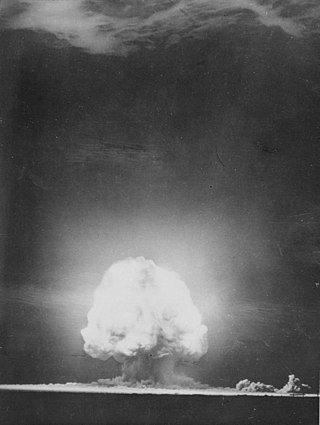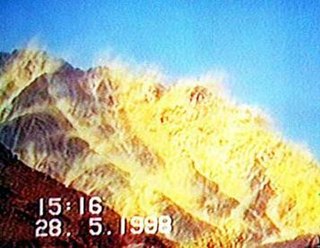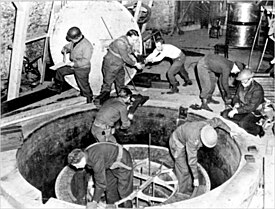Military doctrine is the expression of how military forces contribute to campaigns, major operations, battles, and engagements. A military doctrine outlines what military means should be used, how forces should be structured, where forces should be deployed, and the modes of cooperation between types of forces. "Joint doctrine" refers to the doctrines shared and aligned by multinational forces or joint service operations.

Operation Paperclip was a secret United States intelligence program in which more than 1,600 German scientists, engineers, and technicians were taken from former Nazi Germany to the U.S. for government employment after the end of World War II in Europe, between 1945 and 1959; several were confirmed to be former members of the Nazi Party, including the SS or the SA.

Aaron Bank was a United States Army colonel who founded the US Army Special Forces, commonly known as the "Green Berets". He is also known for his exploits as an OSS officer during World War II, when he parachuted into France to coordinate the French Resistance and organizing an operation intended to capture Adolf Hitler. In retirement, Bank warned about terrorism and modern technology. He is largely responsible for the high level of security at U.S. nuclear power plants since the early 1970s.

Technology played a significant role in World War II. Some of the technologies used during the war were developed during the interwar years of the 1920s and 1930s, much was developed in response to needs and lessons learned during the war, while others were beginning to be developed as the war ended. Many wars have had major effects on the technologies that we use in our daily lives, but World War II had the greatest effect on the technology and devices that are used today. Technology also played a greater role in the conduct of World War II than in any other war in history, and had a critical role in its outcome.

The Alsos Mission was an organized effort by a team of British and United States military, scientific, and intelligence personnel to discover enemy scientific developments during World War II. Its chief focus to investigate the progress that Nazi Germany was making in the area of nuclear technology, and to seize any German nuclear resources that would either be of use to the Manhattan Project or worth denying to the Soviet Union. It also investigated German chemical and biological weapon development and the means to deliver them, and any other advanced Axis technology it was able to get information about in the course of the other investigations.

Operation Big was an operation of the Alsos Mission, the Allied seizure of facilities, materiel, and personnel related to the German nuclear weapon project during World War II. It was tasked with sweeping several targeted towns in the area of southwest Germany designated to the French First Army, including Hechingen, Bisingen, Haigerloch, and Tailfingen.

Kirtland Air Force Base is a United States Air Force base. It is located in the southeast quadrant of the Albuquerque, New Mexico, urban area, adjacent to the Albuquerque International Sunport. The base was named for the early Army aviator Col. Roy C. Kirtland. The military and the international airport share the same runways, making ABQ a joint civil-military airport.

Nazi Germany undertook several research programs relating to nuclear technology, including nuclear weapons and nuclear reactors, before and during World War II. These were variously called Uranverein or Uranprojekt. The first effort started in April 1939, just months after the discovery of nuclear fission in Berlin in December 1938, but ended only a few months later, shortly ahead of the September 1939 German invasion of Poland, for which many notable German physicists were drafted into the Wehrmacht. A second effort under the administrative purview of the Wehrmacht's Heereswaffenamt began on September 1, 1939, the day of the invasion of Poland. The program eventually expanded into three main efforts: Uranmaschine development, uranium and heavy water production, and uranium isotope separation. Eventually, the German military determined that nuclear fission would not contribute significantly to the war, and in January 1942 the Heereswaffenamt turned the program over to the Reich Research Council while continuing to fund the activity.

Hechingen is a town in central Baden-Württemberg, Germany. It is situated about 60 kilometres (37 mi) south of the state capital of Stuttgart and 90 kilometres (56 mi) north of Lake Constance and the Swiss border.
The Allies of World War II cooperated extensively in the development and manufacture of new and existing technologies to support military operations and intelligence gathering during the Second World War. There are various ways in which the allies cooperated, including the American Lend-Lease scheme and hybrid weapons such as the Sherman Firefly as well as the British Tube Alloys nuclear weapons research project which was absorbed into the American-led Manhattan Project. Several technologies invented in Britain proved critical to the military and were widely manufactured by the Allies during the Second World War.

The Soviet Alsos or Russian Alsos is the western codename for an operation that took place during 1945–1946 in Germany, Austria, and Czechoslovakia, in order to exploit German atomic related facilities, intellectual materials, material resources, and scientific personnel for the benefit of the Soviet atomic bomb project. The contributions of the German scientists is borne out by the many USSR State Prizes and other awards given in the wake of the second Soviet atomic bomb test, a uranium-based atomic bomb; awards for uranium production and isotope separation were prevalent. Also significant in both the first Soviet atomic bomb test – a plutonium-based atomic bomb which required a uranium reactor for plutonium generation – and the second test, was the Soviet acquisition of a significant amount of uranium immediately before and shortly after the close of World War II. This saved the Soviets at least a year by their own admission.
The political history of Pakistan is the narrative and analysis of political events, ideas, movements, and leaders of Pakistan. Pakistan gained independence from the United Kingdom on 14 August 1947, when the Presidencies and provinces of British India were divided by the United Kingdom, in a region which is commonly referred to as the Indian subcontinent. Since its independence, Pakistan has had a colorful yet turbulent political history at times, often characterized by martial law and inefficient leadership.

Robert Ralph Furman was a civil engineer who during World War II was the chief of foreign intelligence for the Manhattan Engineer District directing espionage against the German nuclear energy project. He participated in the Alsos Mission, which conducted a series of operations with the intent to place all uranium in Europe into Allied hands, and at the end of the war rounded up German atomic scientists to keep them out of the Soviet Union. He personally escorted half of the uranium-235 necessary for the Little Boy atomic bomb to the Pacific island of Tinian. He was also a key figure overseeing the construction of The Pentagon building. After the war he founded Furman Builders Inc., a construction company that built hundreds of structures, including the Potomac Mills shopping mall in Woodbridge, Virginia.

T-Force was the operational arm of a joint US Army–British Army mission to secure German scientific and industrial technology before it could be destroyed by retreating German forces or looters during the final stages of the Second World War and its aftermath. Key personnel were also to be seized and targets of opportunity exploited when encountered. The effort was a business and technology-oriented parallel of sorts to the Monuments Men pursuit of art and financial treasure.

Project-706, also known as Project-786 was the codename of a research and development program to develop Pakistan's first nuclear weapons. The program was initiated by Prime Minister Zulfiqar Ali Bhutto in 1974 in response to the Indian nuclear tests conducted in May 1974. During the course of this program, Pakistani nuclear scientists and engineers developed the requisite nuclear infrastructure and gained expertise in the extraction, refining, processing and handling of fissile material with the ultimate goal of designing a nuclear device. These objectives were achieved by the early 1980s with the first successful cold test of a Pakistani nuclear device in 1983. The two institutions responsible for the execution of the program were the Pakistan Atomic Energy Commission and the Kahuta Research Laboratories, led by Munir Ahmed Khan and Abdul Qadeer Khan respectively. In 1976 an organization called Special Development Works (SDW) was created within the Pakistan Army, directly under the Chief of the Army Staff (Pakistan) (COAS). This organization worked closely with PAEC and KRL to secretly prepare the nuclear test sites in Baluchistan and other required civil infrastructure.

The National Air and Space Intelligence Center (NASIC) is the United States Air Force unit for analyzing military intelligence on foreign air forces, weapons, and systems. NASIC assessments of aerospace performance characteristics, capabilities, and vulnerabilities are used to shape national security and defense policies and support weapons treaty negotiations and verification. NASIC provides the Defense Intelligence Agency (DIA) with specialized intelligence regarding foreign air threats.

John Lansdale Jr. was a United States Army colonel who was in charge of intelligence and security for the Manhattan Project.

An air force in the broadest sense is the national military branch that primarily conducts aerial warfare. More specifically, it is the branch of a nation's armed services that is responsible for aerial warfare as distinct from an army aviation or naval aviation units. Typically, air forces are responsible for gaining control of the air, carrying out strategic and tactical bombing missions, and providing support to land and naval forces often in the form of aerial reconnaissance and close air support.

The 1269th Engineer Combat Battalion was an engineer combat battalion that served in the United States Army in the European Theater of Operations during World War II. It saw action in France and Germany, serving notably with the Army's T-Force intelligence assault force in the capture of German atomic weapons facilities and personnel as part of Operation Big.














